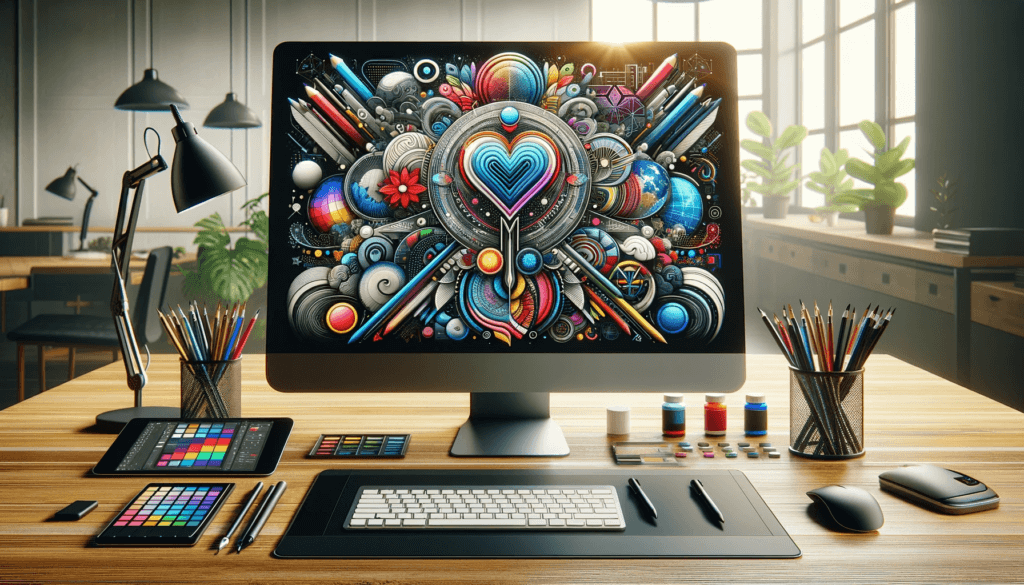Author: Ayesha
Table of Contents
ToggleAs we enter 2024, graphic design continues to play a crucial role in shaping the visual dimensions of our digital era. It’s more than just an art form; it’s a powerful communication tool that bridges creativity with functionality, influencing how we perceive and interact with the digital world. From branding and marketing to user interface design and social media, the influence of graphic design is pervasive, making it an essential element in both business and personal expression.
In this rapidly evolving landscape, the tools and software available for graphic design have become more sophisticated and diverse, catering to a wide array of needs and skill levels. Recognizing the importance of having the right tools in your creative arsenal, we have compiled a list of the 20 best graphic design software tools of 2024. This curated selection is designed to guide beginners and professionals in finding the software that best suits their creative demands and workflow preferences.
20 Graphic Design Apps & Tools to Try
1. Adobe Illustrator
-
- Industry Dominance: Adobe Illustrator is the leading software for vector graphic design and is renowned for its precision and advanced capabilities.
- Key Features: Boasts powerful tools for creating scalable vector graphics, intricate illustrations, logos, and typography.
- Usability: Known for its comprehensive and versatile toolset, suitable for both simple designs and complex artwork.
- Ideal User Profile: Widely used by professional graphic designers, illustrators, and artists.
- Typical Use Cases: Essential for branding, vector illustrations, product packaging, and web design.
2. Affinity Designer
-
- Alternative to Adobe: Affinity Designer emerges as a strong competitor to Adobe, offering robust features at a competitive price.
- Features and Interface: Known for its speed, precision, and advanced vector tools, along with a user-friendly interface.
- Performance: Delivers high performance on both Mac and Windows platforms, easily handling complex designs.
- Pricing: Offers a one-time purchase model, making it an affordable alternative.
- Target Audience: Appeals to graphic designers and illustrators looking for a cost-effective yet powerful tool.
3. Procreate
-
- Digital Painting and Illustration: Procreate is acclaimed for its exceptional capabilities in digital painting and illustration.
- Intuitive Interface: Features an intuitive, touch-friendly interface optimized for iPad use.
- Unique Features: Offers an extensive library of brushes and the ability to create custom brushes.
- Popularity: Highly popular among tablet users, especially iPad users, for on-the-go creativity.
4. Adobe Photoshop
-
- Comprehensive Toolset: Adobe Photoshop is the industry standard for photo editing, offering a vast array of editing tools.
- Versatility: Its versatility extends to graphic design, web design, and 3D modeling.
- Learning Curve: While powerful, it has a steep learning curve for beginners.
- Subscription Model: Available through Adobe’s Creative Cloud subscription, offering regular updates and cloud storage.
5. Affinity Photo
-
- Photoshop Competitor: Positions itself as a direct competitor to Photoshop, offering similar features for photo editing and graphic design.
- Features and Performance: Includes comprehensive editing tools, layer support, and non-destructive editing, with strong performance across platforms.
- Pricing and Feedback: Attracts users with its no-subscription, one-time purchase model, receiving positive feedback for its affordability and capabilities.
6. Canva
-
- Democratizing Design: Canva has revolutionized the graphic design landscape by making design accessible to everyone, regardless of their design experience.
- User-Friendly Interface: Known for its simplicity and ease of use, with drag-and-drop functionality and a vast array of templates.
- Suitability: Ideal for non-designers and small businesses looking to create professional-looking designs without the need for complex software.
7. CorelDRAW
-
- Veteran Status: CorelDRAW holds a long-standing reputation as a powerful vector graphic design software.
- Unique Features and Toolsets: Offers a range of specialized tools for vector illustration, layout, photo editing, and typography.
- Target Audience and Industry Use: Widely used by graphic professionals in industries like advertising, printing, and fashion design.
8. Adobe InDesign
-
- Desktop Publishing: InDesign is Adobe’s premier tool for desktop publishing, specializing in layout design for print and digital publications.
- Integration with Adobe Products: Seamlessly integrates with other Adobe Creative Cloud apps like Photoshop and Illustrator, enhancing workflow.
- Use in Layout Design: Extensively used for creating complex document layouts, magazines, brochures, e-books, and interactive PDFs.
9. Pixlr
-
- Web-Based Editing Tool: Pixlr offers a convenient and accessible platform for image editing, available directly in the web browser.
- Features and Suitability: Equipped with essential editing tools suitable for quick and straightforward edits.
- Accessibility and User Base: Popular among users who need a readily accessible and easy-to-use tool for fast image modifications.
10. Figma
-
- UI/UX Design Role: Figma has emerged as a leading tool in the UI/UX design space, known for its efficiency in designing interfaces.
- Collaborative Features: Offers real-time collaboration, allowing teams to work together seamlessly on a cloud-based platform.
- Popularity Among Designers: Gaining increasing popularity for its user-friendly interface and collaborative capabilities, making it a go-to choice for design teams and solo designers alike.
11. Sketch
-
- Vector-Based UI Design Tool: Sketch is recognized for its proficiency in vector-based user interface design.
- macOS Exclusivity: Exclusively available for macOS, offering a streamlined experience for Apple users.
- Comparison with Figma: While similar to Figma in functionality, Sketch differentiates itself with its macOS optimization and extensive plugin ecosystem.
12. Vista Create
-
- Social Media Graphics: Vista Create, formerly known as Crello, specializes in creating eye-catching social media graphics.
- Template-Based Design: Offers a wide range of customizable templates, making graphic creation accessible and efficient.
- Target Audience: Ideal for marketers, bloggers, and small businesses looking to enhance their social media presence.
13. PhotoScape X
-
- All-in-One Photo Editing Toolkit: PhotoScape X is known for its comprehensive set of photo editing tools.
- Features and Ease of Use: Offers an intuitive interface with features like batch editing, collage making, and GIF creation.
- Target Audience and Platform Support: This appeals to a broad audience, from beginners to intermediate users, and is available on multiple platforms.
14. Vectr
-
- Free Web-Based Vector Editor: Vectr is a user-friendly, free tool for creating vector graphics directly in a web browser.
- Usability and Features: Simple interface with essential vector editing tools, suitable for quick designs and edits.
- Beginner-Friendly: Particularly appealing to beginners due to its ease of use and accessibility.
15. Krita
-
- Digital Painting and Illustration: Krita focuses on providing a comprehensive platform for digital artists, particularly in painting and illustration.
- Open-Source and Community Support: As an open-source tool, it benefits from a supportive community and regular updates.
- Comprehensive Brush Toolkit: Offers an extensive selection of brushes and customization options, catering to artists’ diverse needs.
16. Inkscape
-
- Free Vector Graphics Editor: Inkscape is a popular open-source vector graphics editor.
- Features and Adobe Illustrator Comparison: Provides a suite of features comparable to Adobe Illustrator, making it a viable free alternative.
- Open-Source Community Popularity: Highly regarded within the open-source community for its capabilities and flexibility.
17. GIMP
-
- Free Photoshop Alternative: GIMP is widely recognized as a free alternative to Adobe Photoshop.
- Features and Customization: Offers a range of photo editing and graphic design features, along with extensive customization options.
- Learning Curve and User Base: While it has a steeper learning curve, it’s popular among hobbyists, artists, and designers for its versatility.
18. Lunacy
-
- AI-Assisted Graphic Design Software: Lunacy stands out with its integration of AI assistance in graphic design.
- Features and Platform Availability: Offers a modern interface with features like built-in design assets and real-time collaboration, available on multiple platforms.
- Unique Selling Points: Known for its speed, lightweight design, and AI-powered tools, catering to a modern design workflow.
19. Visme
-
- Presentations and Infographics: Visme specializes in creating visually appealing presentations and infographics.
- Ease of Use and Templates: Features an easy-to-use interface with a wide range of customizable templates.
- Business and Education Applications: Widely used in business and education sectors for creating engaging visual content.
20. Flipsnack
-
- Digital Publications Creation: Flipsnack is tailored for creating and sharing digital publications like magazines and catalogs.
- Features and Usability: Offers intuitive tools for designing, publishing, and sharing digital content.
- Target Audience: Ideal for marketers, educators, and publishers looking to create interactive digital publications.
Conclusion
- Diversity and Strengths Recap: This comprehensive list showcases the diversity and unique strengths of each best graphic design software tool. From industry staples like Adobe Illustrator and Photoshop, known for their advanced capabilities and wide-ranging applications, to user-friendly platforms like Canva and Vista Create, ideal for non-designers and small businesses. Tools like Figma and Sketch cater to UI/UX designers, while Krita and Procreate are perfect for digital artists. Each software brings something unique to the table, whether it’s the vector precision of CorelDRAW, the desktop publishing prowess of Adobe InDesign, or the collaborative nature of cloud-based platforms.
- Choosing the Right Tool: We encourage our readers to consider their specific design needs, skill level, and project requirements when selecting a graphic design tool. Whether you require comprehensive photo editing features, vector design capabilities, or user-friendly interfaces for quick graphic creation, there’s a tool tailored to meet those needs. Reflect on what aspects of design are most crucial to your work or hobby, and let that guide your choice.
- Invitation for Feedback: Your experiences and insights are invaluable to us and the wider design community. We invite you to share your thoughts, feedback, or suggestions about these tools. Have you discovered additional features that others might find helpful? Do you have tips for beginners starting out with these tools? Or perhaps you have a recommendation for a tool that didn’t make our list? Whatever your input, we’d love to hear from you. Share your thoughts in the comments below or reach out to us directly. Let’s continue to learn, grow, and create together in this vibrant and ever-evolving world of graphic design.
FAQs
Which software is best for graphic designing?
-
- The best graphic design software in 2024 depends on your specific needs and skill level. Adobe Illustrator and Photoshop remain industry standards for vector graphics and photo editing, respectively. Canva and Vista Create are excellent for non-designers due to their user-friendly interfaces and extensive template libraries. For UI/UX design, Figma and Sketch offer powerful features. Ultimately, the best software is one that aligns with your project requirements and personal workflow.
What is the future of graphic design in 2024?
-
- The future of graphic design in 2024 is shaping up to be an exciting fusion of technology and creativity. Trends indicate a rise in immersive experiences like AR and VR, a greater emphasis on sustainability in design, and the continued importance of UI/UX design. Additionally, the integration of AI in design tools is expected to streamline the creative process, making it more efficient and accessible.
Are graphic designers in demand in 2024?
-
- Yes, graphic designers are in high demand in 2024. With the continuous growth of digital media, e-commerce, and online marketing, skilled graphic designers are needed to create visually appealing and effective designs. The demand is particularly high for designers specializing in digital mediums, UI/UX, and interactive design.
Who is No 1 graphic designer?
-
- Identifying the number one graphic designer is subjective and varies based on criteria like influence, creativity, and innovation. Renowned designers like Paula Scher, Milton Glaser, and Stefan Sagmeister have been influential. However, numerous emerging talents continue to shape the industry, making it a field characterized by diverse leadership and creativity.
What are graphic tools?
-
- Graphic tools are software applications and platforms used to create, edit, and manipulate visual content. These tools can range from vector graphics editors and photo editing software to layout design programs and digital illustration apps. They are essential in creating everything from simple designs to complex visual projects.
Can I use Figma for graphic design?
-
- Absolutely, Figma is an excellent tool for graphic design, particularly for UI/UX design and collaborative projects. Its cloud-based platform allows for real-time collaboration, making it ideal for team-based projects. Figma’s vector tools and design features also make it suitable for a wide range of graphic design tasks.
Is graphic design a good career in 2024?
-
- Graphic design is a promising career in 2024, thanks to the growing need for skilled designers in various industries. The field offers opportunities for creative expression, technological innovation, and versatility in career paths, ranging from freelance work to corporate employment. Continuous learning and adaptation to new trends and tools are key to thriving in this field.
Where will graphic design be in 10 years?
-
- In the next 10 years, graphic design is likely to see significant evolution with advancements in technology. Expect more integration of 3D design, motion graphics, and virtual/augmented reality. AI and machine learning will play a larger role in automating some aspects of design, leading to new creative possibilities and efficiencies.
Is AI replacing graphic designers?
-
- While AI is increasingly used in graphic design, it’s unlikely to replace human graphic designers entirely. AI can automate repetitive tasks and offer new tools, but the creative insight, emotional intelligence, and understanding of cultural nuances that human designers bring are irreplaceable. AI is expected to be a tool that enhances, rather than replaces, the work of graphic designers.


























